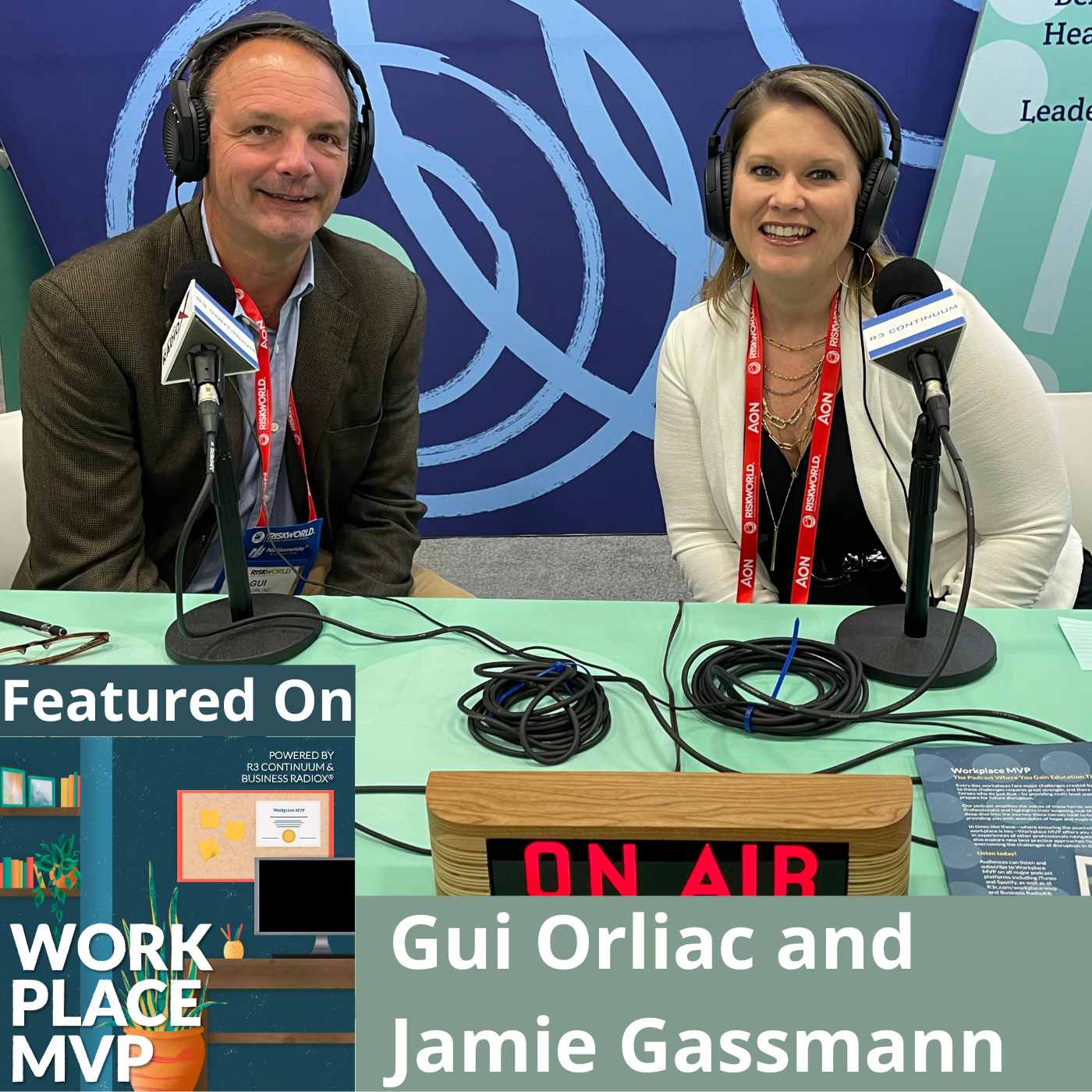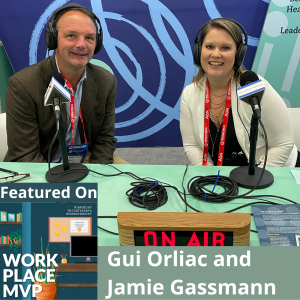
LIVE from RISKWORLD 2022: Gui Orliac, SpeedGauge
Gui Orliac with SpeedGauge was Jamie Gassmann’s guest on this live episode from RISKWORLD 2022. Gui explained that SpeedGauge is a product that creates risk models for commercial fleet drivers to reduce the risk for the companies that use them. He and Jamie talked about how the score is created, the variables involved such as locations and types of roads, the ways companies use the data, and much more.
Workplace MVP is underwritten and presented by R3 Continuum and produced by the Minneapolis-St.Paul Studio of Business RadioX®.
This show was originally broadcast from the RIMS 2022 RISKWORLD Conference held at the Moscone Center in San Francisco, California.
SpeedGauge
SpeedGauge is a driving analytics and performance company. Their focused, effective solutions help fleets manage and improve driving behaviors to transform a company’s approach to driving, reduce risk, strengthen business operations and enhance financial results.
SpeedGauge is devoted to helping customers protect their businesses, their drivers, and the motoring public.
Company website | LinkedIn | Facebook
Gui Orliac, Director of Revenue Development, SpeedGauge

About Workplace MVP
Every day, around the world, organizations of all sizes face disruptive events and situations. Within those workplaces are everyday heroes in human resources, risk management, security, business continuity, and the C-suite. They don’t call themselves heroes though. On the contrary, they simply show up every day, laboring for the well-being of employees in their care, readying the workplace for and planning responses to disruption. This show, Workplace MVP, confers on these heroes the designation they deserve, Workplace MVP (Most Valuable Professionals), and gives them the forum to tell their story. As you hear their experiences, you will learn first-hand, real-life approaches to readying the workplace, responses to crisis situations, and overcoming challenges of disruption. Visit our show archive here.
Workplace MVP Host Jamie Gassmann

In addition to serving as the host to the Workplace MVP podcast, Jamie Gassmann is the Director of Marketing at R3 Continuum (R3c). Collectively, she has more than fourteen years of marketing experience. Across her tenure, she has experience working in and with various industries including banking, real estate, retail, crisis management, insurance, business continuity, and more. She holds a Bachelor of Science Degree in Mass Communications with special interest in Advertising and Public Relations and a Master of Business Administration from Paseka School of Business, Minnesota State University.
R3 Continuum
R3 Continuum is a global leader in workplace behavioral health and security solutions. R3c helps ensure the psychological and physical safety of organizations and their people in today’s ever-changing and often unpredictable world. Through their continuum of tailored solutions, including evaluations, crisis response, executive optimization, protective services, and more, they help organizations maintain and cultivate a workplace of wellbeing so that their people can thrive. Learn more about R3c at www.r3c.com.
Company website | LinkedIn | Facebook | Twitter
TRANSCRIPT
Intro: [00:00:03] Broadcasting live from Riskworld 2022 at the Moscone Center in San Francisco, it’s time for Workplace MVP. Brought to you by R3 Continuum, a global leader in helping workplaces thrive during disruptive times. Now, here’s your host.
Jamie Gassmann: [00:00:23] Hi, everyone. Your host, Jamie Gassmann here at the Riskworld 2022 live from the R3 Continuum booth in our Expo Hall. And with me is Gui Orliac. And Gui, which company are you with?
Gui Orliac: [00:00:38] Hi, Jamie. Thank you for having me.
Jamie Gassmann: [00:00:39] You’re welcome.
Gui Orliac: [00:00:40] And I’m with a company called Speed Gauge. And what we do, we do risk analytic for commercial fleet or commercial auto. We look at driving behavior and helping the whole commercial world, looking at evaluating risk on the road.
Jamie Gassmann: [00:01:02] Yeah. And talking to you before we jumped on the mics, you were talking about that these are the commercial vehicles that an organization would own. And looking at the risk that’s involved in the drivers driving those vehicles and how somebody should be evaluating their risk level, correct?
Gui Orliac: [00:01:18] That’s right. And thank you for asking. I mean, clearly, you pay some attention to some things that I’m not sure, is that sexy? But thank you for looking into that. What’s happening in the commercial auto or basically truck world is that everybody drive differently, and how do you evaluate and know which driver is and what the risk of the driver is per driver, rather than just creating a blanket statement. And this is accentuated even more as we go toward miles-driven insurance.
Gui Orliac: [00:02:00] So then, you need to evaluate risk based on mileage, not just based on overall, if you have 10 trucks, or 20 trucks, or 100 trucks. And another aspect of that, you want to evaluate risk based on where the company is driving. So, are they driving in a city or are they driving on the highway? And so, once you evaluate the risk, you want to be able to provide insights to the drivers and their manager to help them get better at doing their job.
Jamie Gassmann: [00:02:31] So, in looking at that risk, and I know we were kind of talking a little bit about those drivers, how does your data help you in identifying, because not all of us drive the same?
Gui Orliac: [00:02:42] That’s right.
Jamie Gassmann: [00:02:43] But a lot of the times, I hear, it’s like, oh, well, there’s 16, so they got to pay more, because they’re 16, but you may have a more responsible 16-year-old driver than a 30-year-old driver, so tell me a little bit about how you analyze that.
Gui Orliac: [00:02:55] Exactly. I mean, I think that’s just really the fundamental of it, and I think we are going to see that more in point as you continue to have a shortage of commercial drivers. In the trucking industry, there had always been a shortage of commercial driver, but with the disruption in supply chain, and the disruption, which is linked to COVID and the retirement, you have less and less drivers. So then, you need to bring new drivers working for you. And in general, the world of risk look at a driver based on the amount of time they have been driving rather than on the driver behavior.
Gui Orliac: [00:03:38] And so, what we do, because of our relationship with over 100 telematic providers, because the commercial industry, the commercial auto industry is very fragmented, and because of the work we do with the GPS providers, the telematic providers, we have been able to have access to the data in a broad basis. Okay. And so, we have created a risk model that is very broad and that can provide each individual fleet, each individual insurance company insight on each individual truck and driver, and how they actually behave, not based on historical data, but based on what we call driven data.
Jamie Gassmann: [00:04:26] Yeah. And I’m guessing that that helps them from a policy perspective and identifying how much insurance they need to purchase, but they might be able to use some of that data, too, from a behavioral perspective in terms of how do they coach their employee, right?
Gui Orliac: [00:04:38] Both. And I think that’s what’s really important, and I think as a company, we started to help company provide insight on how they engage with their employees, and as our solution evolve, we started to offer solution to the insurance industry and develop an insurance way to like a credit score, but for driving risk. And so, now, we have been validating that score for a number of years and a number of large commercial insurance companies are using this scoring to understand and to really target appropriate premium and underwriting based on actual driven data. And I think we are going to see that more as we are going to go, as I was saying, toward miles-driven. So then ,you need to be really accurate on understanding where you drive, how you drive, and how many miles.
Jamie Gassmann: [00:05:41] Yeah. And every city is going to be different too, I’ve noticed, from my own driving in other cities. So, does it take into account location by the city and geographic regions?
Gui Orliac: [00:05:51] It goes even closer than that. It goes to the type of road, primary road, secondary road, toll road, things like that. So, we look at—but not only the type of road, also the time of the day. And do you drive the same way at night? Do you drive the same way at day? Another one is when there’s traffic or no traffic. One thing we noticed, so as an organization, Speed Gauge, has worked in the trucking commercial fleet industry for over 12 years. Okay.
Gui Orliac: [00:06:30] So, we have relationship with many, if not all the telematic providers. It’s hard to have all, but at least many of the telematic providers in North America. And so, we were able to see that, for example, increased speeding happened at the beginning of the pandemic, because, in fact, there was less traffic jam. Isn’t that like really fascinating? In understanding that, so basically contextualizing the data, understanding how what’s happening help people like even the fleet, then they can intervene and say to their drivers, maybe you need to slow down, because a ticket is still a ticket.
Jamie Gassmann: [00:07:15] Yeah. Well, and that increases insurance rates when you get too many speeding tickets, right?.
Gui Orliac: [00:07:20] Exactly. So then, the question become, is it, should you—and I think we are actually making a very astute point, is it a good way to judge a risk having a speeding ticket or any ticket? Because like if you drive in Indiana, so we have data that show, in Indiana, if you get in Indiana, you get a ticket. So, no matter what. Then, the question is, you have other states where you drive, you don’t get tickets. But if you are driving in Indiana, you get a ticket. Okay. So then, the question is, is it relevant? Do you need to take into consideration that if you go to Indiana, you are going to ticket or not? That’s a really interesting second question. Does it mean that you are driving poorly just like in Indiana? That’s where the regular trucking.
Jamie Gassmann: [00:08:06] Yeah. Wow. Interesting.
Gui Orliac: [00:08:08] That’s right.
Jamie Gassmann: [00:08:09] Yeah. And I was going to ask you about during the pandemic, because I know being from the Minneapolis area, I know the roadways got a little bit more dicey with it, became a racetrack, and we weren’t used to that pre-pandemic as many vehicles driving that way. So, what were some of the trending that you’ve seen in the last two years that has made some of your data pulls really interesting?
Gui Orliac: [00:08:32] Well, so I don’t know, I don’t have all of them in mind, but I think like one thing we saw definitely at the beginning of the pandemic, because there was less traffic jam, we saw a significant increase in speeding activities, vehicle moving faster. Does that mean that there was more accident? Not really, because in fact, there was less vehicle on the road. Okay.
Gui Orliac: [00:08:57] So, that’s an interesting contradiction. Okay. Does that mean that you still need not to pay attention to road regulation? I think as an organization, it’s better to be consistent rather than to allow too many variations. And what we have seen is that since then, things have become a little bit more stable, so we are back to a more regular traffic patterns. So, overall, it’s pretty good.
Jamie Gassmann: [00:09:25] Yeah. Slow drivers like myself are now back on the road, they’ve got to watch out. So, quick question, and you may not have an answer to this yet, because I know it’s still pretty new, but with self-driving vehicles coming out from the carrier perspective, has your organization started to look into some of the data on that and plans for how companies can assess the risk of bringing those into their fleet?
Gui Orliac: [00:09:47] Okay. So, I’m not personally looking at self-driving vehicle, per se, but we are looking at data from any type of vehicle. Okay. So, that’s a really interesting differentiation. One, there’s not that many self-driving vehicles on the line today, so that’s really important to keep that in mind. Okay. I think that we are moving forward to what more and more automation of drivers. Okay. I think that’s a good thing because it helps driver to be less tired.
Gui Orliac: [00:10:21] So, assisted driving, I think, has a lot of benefit, and I think fleet and driver are going to benefit from it. I was talking to somebody else at the show today, and they said, well, hopefully, full driver automation vehicle is going to be coming soon, because we don’t have enough drivers. And in some ways, it’s true. We need some help, but I think we are like years away from seeing it actually happening. In small scale, we are going to see it, but like at large scale, I think we are a little bit away. And I think the other thing is that drivers are a great customer relationship person.
Jamie Gassmann: [00:11:04] Oh, completely, yeah.
Gui Orliac: [00:11:05] So, I think like in some ways, it’s—and the question is, are we going to get better services or what type of services with full automation? And I think we don’t know that yet.
Jamie Gassmann: [00:11:17] Yeah, lots to come ahead of us, I’m pretty sure.
Gui Orliac: [00:11:20] Exactly. And so, that’s what’s making this industry quite exciting.
Jamie Gassmann: [00:11:24] I bet.
Gui Orliac: [00:11:25] It’s like changing, evolution, or technology, but I think at the end of the day is what to do with the technology and what to do with the data. And so, from a Speed Gauge perspective, we came up with a way to provide insight to the whole industry. And we believe in transparency so that a fleet can improve, an insurance company can be more accurate, everybody can work together, and we make sure we do that based on permission management, because we do not provide data, and that has not been authorized by all the party involved. And that, I think, is crucial.
Jamie Gassmann: [00:12:02] Yeah, absolutely. Super interesting. Interesting topic and interesting work that you do. I’m so glad you joined us on the show.
Gui Orliac: [00:12:09] No, thank you very much, Jamie, for having me. And I think I could talk a lot about that, but I think most people will be bored very fast about the trucking data, so I will maybe keep it at that, but one thing really important is that it helps people once it’s being used. It has to be used. That’s the truth.
Jamie Gassmann: [00:12:29] Well, data is a very powerful tool, so it tells you a lot when you look at it close enough.
Gui Orliac: [00:12:33] Exactly.
Jamie Gassmann: [00:12:34] Yeah. Well, if anybody wanted to get a hold of you to learn a little bit more about what your company does and like what you do, how can they do that?
Gui Orliac: [00:12:41] Well, they can go to speedgauge.net and they will look for a Frenchman name on their people, and that will be me.
Gui Orliac: [00:12:52] Wonderful.
Gui Orliac: [00:12:53] Thank you very much, Jamie.
Jamie Gassmann: [00:12:54] Yeah, thank you.
Gui Orliac: [00:12:55] And have a good afternoon.
Jamie Gassmann: [00:12:57] You, too.
Gui Orliac: [00:12:58] Bye.
Outro: [00:13:02] Thank you for joining us on Workplace MVP. R3 Continuum is a proud sponsor of this show and is delighted to celebrate most valuable professionals who work diligently to secure safe workplaces where employees can thrive.















